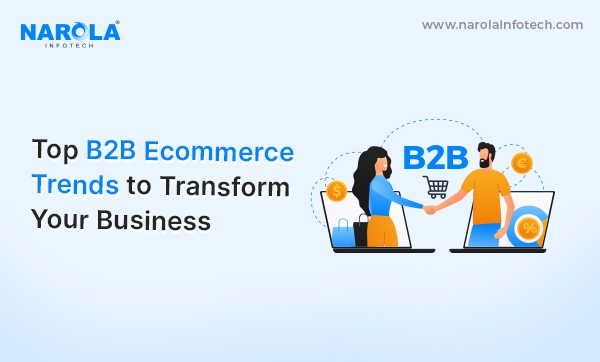Top B2B Ecommerce Trends You Should Know

B2B buyers are no longer constrained to traditional channels and are increasingly expecting convenience and personalization from B2C shopping. Businesses need platforms that meet modern buyer expectations to compete. Building or improving a B2B platform that meets sophisticated business buyers' expectations requires understanding these trends.
This blog covers top B2B ecommerce trends.
1. Self-Service Options
Self-service options are expected to provide convenience and autonomy by today's B2B buyers. Platforms that free consumers from having to speak with salespeople to conduct product research, verify inventory, place orders, and follow shipments will be given special consideration. This tendency expedites the decision-making process and lessens friction in the purchasing process.
2. Generative AI
With its cutting-edge solutions for targeted marketing, customer service, and content production, generative AI is revolutionizing business-to-business e-commerce. The impact is enormous, ranging from generative AI creating customized product descriptions to AI-driven chatbots answering intricate client inquiries.
3. Payment Flexibility
Buyers in B2B expect many payment methods. Integrating credit cards, ACH payments, and net terms for established accounts that suit client needs is crucial. Flexible payment arrangements satisfy various financial demands, encourage purchases, optimize cash flow, and strengthen client relationships.
4. B2C Experience for B2B Buyers
B2B buyers today anticipate B2C ecommerce convenience and personalization. User-friendly websites, tailored recommendations, easy navigation, and smooth checkout are examples. B2B buyers want user-centric platforms because they're used to B2C shopping. Focus on a clean interface and clear product information.
5. Mobile-first Approach
With the growing use of mobile devices for corporate purposes, a mobile-first strategy is critical. Ensuring that your B2B ecommerce platform is completely adapted for mobile devices can cater to buyers on the road while also improving the overall user experience.
6. Automation
Using automation is critical for streamlining operations in B2B ecommerce. Businesses can greatly improve their efficiency and responsiveness by introducing automated solutions in areas such as inventory management, order processing, and customer service. It not only lowers operational costs, but also eliminates errors, resulting in smoother transactions.
7. Omnichannel Strategy
An good omnichannel approach includes several touchpoints to ensure real-time inventory visibility and a consistent customer experience. Integrating your platform with online retailers, mobile apps, marketplaces, and CRM systems allows you to deliver a consistent brand experience. This builds trust and loyalty among customers, regardless of how they interact with your company.
8. B2B Marketplaces
B2B marketplaces are gaining popularity, providing firms with an additional avenue to meet potential buyers. These platforms offer a diverse range of items and services, making it easier for customers to compare and buy, while also increasing seller visibility and sales prospects.
9. Streamlined Repurchasing with Recurring Orders
Repeating B2B transactions are common. Subscription models and automated reordering can simplify buying and give sellers a consistent cash stream. This trend meets B2B convenience and reliability needs.
10. Data-Driven Decisions
Businesses may quickly respond to changing conditions and optimize their strategy by incorporating real-time data analytics into their platform to obtain insights into customer behavior, buying patterns, inventory trends, and operational performance.
11. Digitization
Digitizing and simplifying company operations boosts efficiency and cuts expenses. Digital solutions are essential for B2B competitiveness, from digital invoicing and electronic signatures to automated supply chain management.
12. Composable Commerce
Building a B2B platform with composable and headless commerce architectures is powerful. They let companies separate their ecommerce platforms' front- and back-ends. This flexibility allows faster updates, easier integrations, and user experience customization without interrupting backend operations. Scalability accommodates future expansion and technological advances.
13. Personalization
Personalization is essential for satisfying the expectations of today's B2B buyers. Businesses can use data analytics and AI to provide personalized product recommendations, customized pricing, targeted marketing messages, and content suggestions.
The B2B online sales world is booming! By keeping an eye on the latest trends and adapting them to your business, you can build a top-notch platform that makes buying easier for your customers, saves you time and effort, and helps your business grow like crazy!
Source : B2B Ecommerce Trends
- Industry
- Art
- Causes
- Crafts
- Dance
- Drinks
- Film
- Fitness
- Food
- Games
- Gardening
- Health
- Home
- Literature
- Music
- Networking
- Other
- Party
- Religion
- Shopping
- Sports
- Theater
- Wellness
- News


